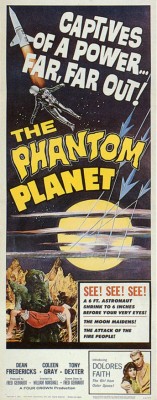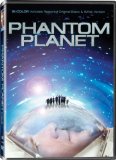| Reviews & Columns |
|
Reviews DVD TV on DVD Blu-ray 4K UHD International DVDs In Theaters Reviews by Studio Video Games Features Collector Series DVDs Easter Egg Database Interviews DVD Talk Radio Feature Articles Columns Anime Talk DVD Savant Horror DVDs The M.O.D. Squad Art House HD Talk Silent DVD
|
DVD Talk Forum |
|
|
| Resources |
|
DVD Price Search Customer Service #'s RCE Info Links |
|
Columns
|
|
|
Phantom Planet, The
The film is presumed to be in the public domain. A number of video labels have been selling it, including one pretty good version from Image sourced from collector Wade Williams. Williams' print may also have been the source for this release from Legend Films. (No one is credited anywhere on the packaging or DVD, however.) It includes both the original black and white version plus a new colorized one. More on that below.
In 1980, U.S. Air Force astronaut Captain Frank Chapman (Dean Fredericks) is sent to investigate a wayward asteroid. His co-pilot (Richard Weber) is killed en route, but he makes it to the seemingly dead rock only to be surprised by Lilliputian-sized humanoids. In the film's best scene, the planet's gases, or gravity, or something, shrink him down to their size, and in a neat little effect we see his face shrink inside his space helmet and his flight suit deflate as he gets smaller and smaller.
Chapman is tried and convicted by the asteroid's leader, Sessom (silent film star Francis X. Bushman, here obviously reading cue cards), to remain there as a "free citizen" with the option of marrying either Sesson's blonde daughter, Liara (Coleen Gray, former Leech Woman), or mute brunette Zetha (Dolores Faith, an Elizabeth Taylor type). Herron (Tony Dexter), Sessom's right-hand man, already loves Liara so, feeling threatened, challenges Chapman to a duel, which thrills Liara to no end. Later the asteroid, called Rehton, is attacked by a race of Fire Monsters known as Solarites, intent on bombarding the planet with their little flaming spaceships while a Solarite prisoner (Richard Kiel, future "Jaws" of the James Bond movies) escapes and is soon wreaking havoc.
Though it's easy to make fun of pictures like this - as the folks at Mystery Science Theater 3000 already have - the film is no worse than average compared with other low-budget sci-fi pictures of the late-1950s and early-'60s. It was probably made for around $75,000-$100,000 and is ambitious here and there. Bob Kinoshita, a talented art director, designed the sets and co-produced the film; his interiors for the spaceship and a cramped moonbase are pretty believable compared to other similarly low-budget films, though the rocky asteroid and its lost civilization is depressingly barren and devoid of character. The film is long for its budget and lowercase status (82 minutes) yet uneventful, and the dialogue is crammed with absurd pseudo-scientific gobbledygook.
The low budget and short shooting schedule (surely less than 10 days) meant that there's an awful lot of repetition on the few sets, with the same camera set-ups used for what's supposed to be three different spaceships, and the same angles at the moonbase where an Air Force Colonel (Dick Haynes) anxiously awaits news on MIA Chapman's whereabouts.
Fredericks, reprising his character from Steve Canyon in all but name, underplays Chapman and, while a bit stoic, has an air of verisimilitude and his final dialogue is almost touching, this despite the fact that it revolves around one of the hoariest cliches in all of fantasy literature.
Undoubtedly the most memorable thing about The Phantom Planet ("Phantom Planet in Color" on the packaging) is its hopelessly and literally "Goofy" monster. It actually does sort of resemble Disney's famous dog (all that's missing is a little green hat and black vest), and because of the costume's ludicrous design, shares Goofy's clumsiness. Kiel likely also played the entire squadron of fighter pilot Solarites. Quoting Bill Warren's invaluable Keep Watching the Skies!, the ships "resemble small blazing coals whizzing through space. Occasionally, they join up into strings, making the battle look like a big rock under attack by shish kebabs....We see a Solarite in his ship, looking up close like a blazing orange crate; he is roaring, apparently with good reason."
Kiel must have had a difficult time seeing out of what must have been a heavy mask because he walks around the rocky set very gingerly, as if worried he could fall and break his neck.
Video & Audio
Legend Video's DVD of The Phantom Planet has its good and bad points. Neither the colorized nor the original monochrome version is 16:9 enhanced widescreen but rather full frame, this despite the fact that The Phantom Planet was released theatrically at 1.85:1 widescreen. Zoomed in at 1.78:1 on widescreen TVs, the movie looks nearly perfectly framed; fortunately the colorized version especially is very sharp and even compromised in this manner still looks quite good. Another plus is that the black and white version really is the black and white version, not the colorized version with the color turned off like Sony's similarly colorized titles (selected Three Stooges shorts, Ray Harryhausen's black & white films), which tend to make the original monochrome films' blacks look washed out and waxy.
As for the colorization itself, technically it's much improved since the early days, but the pallet is still very unnatural (the actors faces all looked dipped in bronze like Sophia Loren) and limited. It doesn't remotely look like something filmed on Eastman Color stock, but rather very closely resembles the look of tinted lobby cards from this same era. Having seen the film twice before in black and white, it was fun seeing it in color, but the grays of the spaceships, the rocky asteroid, and the blackness of space don't really lend themselves all that well to the process. There's also one significant mistake; whoever colorized the Solarite monster didn't realize what looks like a potato sack and a slacks is actually supposed to be a full-body monster suit, i.e., the creature's skin. Instead, the monster's hands are colored pinkish but these end at the wrist, accentuating rather than hiding the poor design.
The 2.0 mono audio appears lifted directly from a 16mm or 35mm print, as it's full of pops and other wear-related noise, though it's otherwise okay. The disc is Closed-Captioned.
Extra Features
The only extras are interesting colorized quasi-trailers for other Legend titles, including Night of the Living Dead and Plan 9 from Outer Space, also public domain. It looks like Legend used footage from their colorized masters, and then tried to recreate the original trailers fairly closely replicating their title fonts, etc.
Parting Thoughts
Fans of 1950s-style low-budget sci-fi films may want to pick this up if they don't already have the film on DVD and are curious about seeing it colorized - while maintaining a decent reference copy of the black and white version. It's a very minor, frequently silly little film, but a treat for those of us with a fondness for such things. Rent It.
Film historian Stuart Galbraith IV's latest book, The Toho Studios Story, is on sale now.
|
| Popular Reviews |
| Sponsored Links |
|
|
| Sponsored Links |
|
|
| Release List | Reviews | Shop | Newsletter | Forum | DVD Giveaways | Blu-Ray | Advertise |
|
Copyright 2024 DVDTalk.com All Rights Reserved. Legal Info, Privacy Policy, Terms of Use,
Manage Preferences,
Your Privacy Choices | |||||||














